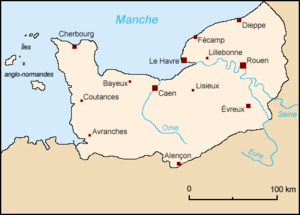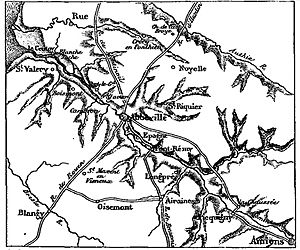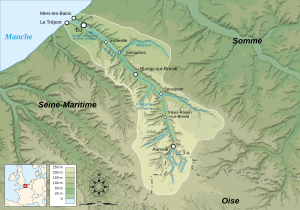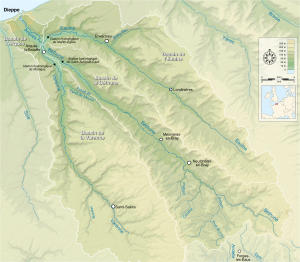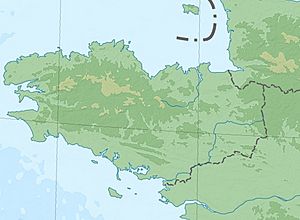Operation Cycle facts for kids
Quick facts for kids Operation Cycle |
|
|---|---|
| Part of the Battle of France | |
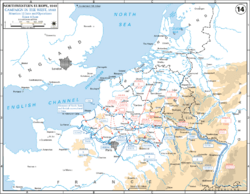
The German offensive to the Seine, 4–12 June 1940.
|
|
| Type | Evacuation |
| Location | Le Havre 49°29′N 00°06′E / 49.483°N 0.100°E |
| Objective | Withdrawal |
| Date | 10–13 June 1940 |
| Executed by | Royal Navy French Navy Allied naval vessels |
| Outcome | Allied success |
Operation Cycle was the name for a brave rescue mission during World War II. It happened in June 1940, towards the end of the Battle of France. Allied soldiers, including British and French troops, were stuck in Le Havre, a port city in France. They needed to escape before the German army captured them.
This operation came soon after the famous Operation Dynamo, where many soldiers were rescued from Dunkirk. The Germans had moved quickly, cutting off Allied armies in the north of France. Soldiers south of the Somme River tried to defend their positions. They also tried to push the Germans back.
The 1st British Armoured Division arrived in France in May. It joined many other troops who were not fully trained or armed. These soldiers were quickly formed into new groups, like the Beauman Division. French troops also joined the fight. They tried to build strong defenses and launch counter-attacks.
When the final German attack, called Fall Rot (Case Red), began on June 5, the Allied troops were pushed back. German tanks entered Rouen on June 9. This trapped many French and British soldiers. The commanders decided to head for Le Havre. Some troops, called Arkforce, were sent to guard the escape routes.
However, the German army moved even faster. They cut off the path to Le Havre. Many soldiers, including over 6,000 British Highlanders, were forced to retreat to St Valery-en-Caux. Some were rescued by the Navy there. But many others were captured. At Le Havre, from June 10 to 13, over 11,000 British and Allied troops were successfully evacuated. Operation Cycle was followed by Operation Aerial, which rescued even more soldiers from other ports.
Why the Evacuation Happened
The Battle of France Begins
On May 10, 1940, Germany launched a huge attack on France, Belgium, and the Netherlands. This attack was called Fall Gelb. German tanks and soldiers quickly broke through French defenses. They drove west, reaching the Somme River.
By May 20, the Germans captured Abbeville. This town is at the mouth of the Somme River. This move cut off all Allied troops in northern France and Belgium. A counter-attack by British and French forces near Arras on May 21 made the Germans focus on capturing the Channel ports. This stopped them from moving south for a short time.
British Supply Lines
When the Germans reached the coast, they cut off the British Expeditionary Force (BEF) from its main supply bases. These bases were in places like Cherbourg and Nantes. The area between the Somme and the Seine rivers was important for British supplies. Dieppe was a major medical base, and Le Havre was a key supply port.
Many British soldiers were stationed along these supply lines. They were mostly support troops, not combat soldiers. They were quickly organized into groups like the Beauman Division. Their job was to protect these important bases and airfields. But they often lacked proper training and weapons.
German patrols south of the Somme caused panic. The British tried to build new defense lines along rivers like the Andelle and Béthune. They prepared bridges to be blown up if needed.
The Fight for Abbeville
On May 20, German tanks advanced quickly to Abbeville. They captured the town that evening. Only a few British soldiers managed to escape to the south side of the Somme. The 1st British Armoured Division arrived in France around this time. But it was missing important equipment like artillery.
From June 4 to July 4, British and French forces tried to recapture parts of the Abbeville area. They fought hard, but both sides suffered heavy losses. The Allies lost many tanks, and the Germans lost many infantry soldiers. On June 5, the Germans attacked again from their positions south of the Somme. The Allied divisions, already weakened, were pushed back further.
Preparing for the Final Battle
Allied Defenses Get Ready
After the Dunkirk evacuation, many French soldiers returned to France through ports in Normandy and Brittany. About 112,000 French troops came back. Around 100,000 British troops were also in the area, with 60,000 more arriving from England. The French also managed to replace many of their lost tanks. This helped boost their morale.
Many new French soldiers had not seen the earlier defeats. Officers who returned from Dunkirk had learned how to fight German mobile units. They also found that French tanks were often stronger than German ones. The French artillery was also very effective.
From May 23 to 28, the French Seventh and Tenth Armies were rebuilt. General Maxime Weygand changed French tactics. He focused on "defense in depth" to wear down German units. Villages and towns were fortified. New divisions were kept ready to counter-attack and help surrounded units.
Germany's Plan: Fall Rot
On May 21, German General Franz Halder presented Fall Rot (Case Red) to Adolf Hitler. This was the plan to finally defeat France. It was approved on May 31. The main German attack would begin on June 5. German armies would attack around Paris and then move towards the Seine River.
The German plan was to encircle and destroy the Allied armies. German tank divisions, called panzer groups, were key to this plan. They had moved hundreds of miles and were tired. Their vehicles also showed wear and tear. The German air force, the Luftwaffe, would support the ground troops.
The German 4th Army was tasked with attacking the French Tenth Army. Their goal was to quickly capture Le Havre and secure crossings over the Seine River near Rouen.
The German Attack: Fall Rot
June 5: The Attack Begins
On June 5, Fall Rot began. The German 4th Army attacked at 4:00 a.m. They faced the British 51st (Highland) Infantry Division near St. Valery sur Somme. German infantry moved forward, capturing several villages. The British villages were too far apart to support each other.
The 154th Infantry Brigade was pushed back. The 153rd Infantry Brigade was heavily bombed by German Ju 87 Stuka dive-bombers. They were forced back but managed to stop the German advance with machine-gun and artillery fire. The French 31st (Alpine) Division also retreated.
The 51st (Highland) Division was trying to hold a very long front. They were already very tired from earlier battles. British troops held on bravely until they were overwhelmed or had to retreat. The British air force tried to help but had few planes left. The Luftwaffe heavily bombed Rouen, an important city and supply center.
June 6: Retreat to the Bresle
During the night, the British commander, Major-General Victor Fortune, asked for reinforcements and permission to retreat to the Bresle River. No more troops were available. But the French commander agreed to the retreat. The 31st (Alpine) Division would hold one part of the Bresle line, and the 51st (Highland) Division would hold the other.
On June 6, the Germans attacked Oisemont. British and French troops fought back and held their positions. However, reports came in that German tanks had broken through further south. The 5th and 7th Panzer divisions were attacking towards Rouen. This meant the IX Corps on the Bresle River could be cut off.
The British War Office urged the French to allow a retreat south-east. This would lead away from the trap of Le Havre. But General Weygand insisted that the Bresle River must be held at all costs. The RAF continued to bomb German columns and airfields.
June 7: The Situation Worsens
A new British brigade, "A" Brigade of the Beauman Division, was sent to reinforce the 51st (Highland) Division. This division had suffered heavy losses. The Bresle River was a good defensive position, especially where the banks were flooded.
However, the situation to the south-east continued to get worse. The 5th Panzer Division had broken through French lines. They had already outflanked the Bresle line. The 1st Armoured Division was ordered to counter-attack the German advance. But this division was not fully equipped.
General Weygand arrived at the French Tenth Army HQ. He told the officers that this was "the decisive battle of the war." He insisted that the 1st Armoured Division must hold its position. He only allowed them to retreat if they were pushed back. By dawn on June 8, German tanks were close to Rouen. The IX Corps on the Bresle was about to be cut off.
June 8: Rouen Falls
On the Bresle, German troops waited for their tanks to surround the IX Corps. The British tried to push the Germans out of the Haute forêt d'Eu but could not. At dawn, German tanks attacked towards Rouen again.
The 51st (Highland) Division and the Beauman Division were holding the Bresle line. But the 1st Armoured Division had been split up. Its tanks were fighting elsewhere. Other British units were defending the Béthune–Andelle line.
German tanks attacked at Forges and Sigy-en-Bray. They used a trick: captured French tanks with German crews. These "French" tanks attacked from the rear. The British and French were pushed back. German tanks reached Mathonville and pressed towards Rouen.
A British battalion, Syme's Battalion, bravely defended Isneauville near Rouen. They had only been formed a week earlier. They used wire and landmines and fought for three hours. They stopped the Germans from reaching Rouen immediately. But they eventually had to retreat to the Seine River. During the afternoon and night, the rest of the 1st Armoured Division and the Beauman Division also crossed the Seine. This left only the 51st (Highland) Division north of the river.
The French Tenth Army HQ lost contact with the IX Corps. The 51st (Highland) Division also lost contact. They learned that the Germans had reached Rouen. The commanders decided to retreat to Le Havre.
June 9: Trapped at St. Valery
On the morning of June 9, German tanks entered Rouen. French and British troops had already left and blown up the bridges over the Seine. The IX Corps on the Bresle began to retreat. The 51st (Highland) Division tried to move back in stages. But some troops took until mid-morning to reach their new positions.
Some British companies bravely held their positions at the Bresle crossings for six more days. They did not know that fighting north of the Seine had ended. German tanks turned north from Rouen towards Dieppe. They captured a British radio truck, cutting off communication.
The 51st (Highland) Division planned to retreat to the Durdent River. But they found Germans already there. German tanks were reported very close to the division's headquarters. British warships helping the division were damaged by German artillery. The IX Corps was now cut off from Le Havre.
Operation Cycle: The Evacuation
St. Valery-en-Caux Evacuation Attempt
Admiral William James, a British naval commander, arrived at Le Havre on June 10. He learned that ships had been damaged near St. Valery-en-Caux. He decided that a large evacuation must happen that night.
The retreat to the coast began after dark. The troops left their positions without being challenged. General Fortune signaled that evacuation from St. Valery to the mouth of the Durdent River would be needed. Soldiers dumped non-essential equipment to make room on transport vehicles.
The night move was difficult. French troops, some with horses, crowded the roads. Thick fog prevented ships from coming close to shore. An armada of 67 merchant ships and 140 small boats had been gathered. But few had radios, and the fog made signaling impossible. Only at Veules-les-Roses were many soldiers rescued under German artillery fire.
Near dawn, the troops at the harbor were ordered back into the town. General Fortune signaled that escape might still be possible the next night. But then he found out that the local French commander had already surrendered.
Le Havre Evacuation
On June 9, the French port commander at Le Havre sent word that Germans had captured Rouen. He said they were heading for the coast. The French and British commanders decided that escaping through Le Havre was their only hope.
The port commander asked for enough ships to evacuate 85,000 troops. But this went against earlier plans. The British hesitated because they did not know the full situation. General Fortune then sent a message saying the 51st (Highland) Division was retreating to Le Havre. This finally made the British realize the urgency.
General Fortune sent a special force called Arkforce to guard Le Havre. This force included the 154th Infantry Brigade and A Brigade of the Beauman Division. Arkforce moved towards Fécamp on the night of June 9/10. Most of them passed through before the German 7th Panzer Division arrived.
A British demolition team had been in Le Havre since late May. The port was heavily bombed by the Luftwaffe on June 7. Two days later, the British Admiralty ordered an evacuation. Admiral William James sent destroyers and many Dutch small boats to help.
A quick plan was made to block Dieppe harbor. On June 10, three blockships were sent to Dieppe. Two were sunk in the channel. The third hit a mine, preventing it from blocking the inner harbor.
Evacuation at Le Havre began on June 11. It was difficult because the port was damaged by bombing. A troopship, SS Bruges, was hit and beached. The electricity was cut, making cranes useless. Loading vehicles was too slow. On June 12, RAF fighters patrolled the port, stopping more German air raids. Some transport and equipment were saved by sending them across the Seine River.
What Happened Next
Evacuations Continue
A total of 2,137 British and 1,184 French soldiers were rescued from Veules-les-Roses. But the rest, including over 6,000 men of the 51st (Highland) Division, were captured by the German 7th Panzer Division on June 12. This German division continued its advance and reached Cherbourg on June 18.
The largest number of troops were evacuated from Le Havre on the night of June 12/13. The evacuation was finished by dawn. Of the 11,059 British troops evacuated, 9,000 men from A Brigade of the Beauman Division went to Cherbourg. The 154th Infantry Brigade sailed to England via Cherbourg.
The Second BEF
After the Dunkirk evacuation, General Alan Brooke was ordered to create another British Expeditionary Force (BEF) in France. This new BEF would include the 51st (Highland) Division and 1st Armoured Division already in France. The 52nd Lowland Division and the 1st Canadian Division would come from Britain.
Brooke warned that this effort might be pointless, except as a political gesture. He was told he would be under the command of General Weygand. A brigade of the 52nd Lowland Division went to France on June 7. But Brooke himself did not arrive until June 12.
On June 13, the RAF made a huge effort to help the French armies. The Germans had crossed the Seine in the west. French armies near Paris fell back. The German advance threatened RAF airfields. The RAF was ordered to retreat towards Nantes or Bordeaux. But they would continue to support the French as long as they fought.
RAF attacks continued day and night against German units. Fighter planes patrolled the coast and supported bombers. The weather worsened, making flights difficult. The remains of the 1st Armoured Division and two brigades of the Beauman Division were south of the Seine. Only the 157th Infantry Brigade of the 52nd (Lowland) Division fought the Germans.
On June 14, Brooke stopped the rest of the 52nd (Lowland) Division from being sent to France. He was told he was no longer under French command. He had to prepare to withdraw British forces from France. The final Allied evacuation, Operation Aerial, began on June 15.
The Brittany Redoubt Idea
On May 29, the French Prime Minister, Paul Reynaud, asked General Weygand to consider creating a "national redoubt." This would be a strong defensive area around a naval port in the Brittany peninsula. The idea was to keep control of the seas and stay in touch with Allied countries.
This idea was discussed by the French and British governments. On June 5, General Alan Brooke was appointed to command the new BEF for France. The 52nd (Lowland) Infantry Division was sent to Cherbourg. On June 6, Weygand ordered work to begin on the redoubt.
However, German forces crossed the Seine on June 9. This cut off the 51st (Highland) Division. The 52nd (Lowland) Division's assembly point was changed to Rennes in Brittany. The 1st Canadian Infantry Brigade arrived at Brest on June 11. They were sent to Sablé-sur-Sarthe. The idea was that these fresh divisions would help the French Tenth Army retreat.
On June 12, General Charles de Gaulle reported that keeping a redoubt in Brittany was impossible. He suggested Quimper as a place for the government to escape by ship. The British Prime Minister, Winston Churchill, visited France on June 13 and approved the project. But later, he found out that no real agreement had been made.
Without the support of the 52nd Division, the French Tenth Army was cut off from Brittany. Two German divisions entered the peninsula first. This forced the French to retreat south to the Loire River. The idea of a Brittany redoubt came to nothing.


